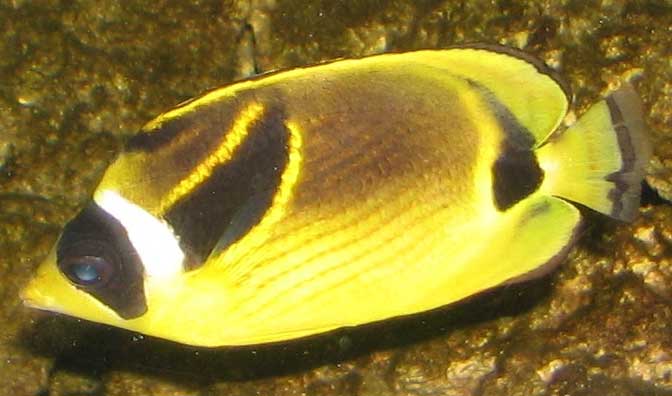Raccoon butterflyfish , Chaetodon lunula (*) Cladus: Eukaryota -------- The raccoon butterflyfish, Chaetodon lunula, also known as the crescent-masked butterflyfish or lunule butterflyfish, is a species of butterflyfish (family Chaetodontidae). It is found in the Indo-Pacific region and in the southeast Atlantic. Its length is up to 20 cm (nearly 8 in).[1] It belongs to the large subgenus Rabdophorus which might warrant recognition as a distinct genus. In this group, its closest relative is probably the very similar Red Sea raccoon butterflyfish or diagonal butterflyfish, C. fasciatus. Other close relatives appear to be the black butterflyfish, C. flavirostris), Philippine butterflyfish, C. adiergastos, and perhaps also the unusual redtail butterflyfish, C. collare. Although the coloration of this group varies greatly, they are all largish butterflyfishes with an oval outline, and most have a pattern of ascending oblique stripes on the flanks. Except in the red-tailed butterflyfish, there is at least a vestigial form of the "raccoon" mask, with a white space between the dark crown and eye areas.[2] In the aquarium The raccoon butterflyfish is generally not aggressive towards other fish, with the exception of lionfish[disambiguation needed] and triggerfish. In captivity, the typical lifespan of a raccoon butterflyfish is five to seven years. It has been observed as a beneficial predator of Aiptasia and Majano sea anemones. They will eliminate this nuisance pest within a two- to six-week period depending on the anemone population and size of the tank; however, they will eagerly feed on any soft corals and may cause more harm than good to the decoration. In a confined environment, this species is prone to succumbing to "marine ich", infection by the ciliate Cryptocaryon irritans. Footnotes 1. ^ FishBase [2008]
Source: Wikipedia, Wikispecies: All text is available under the terms of the GNU Free Documentation License |
|

